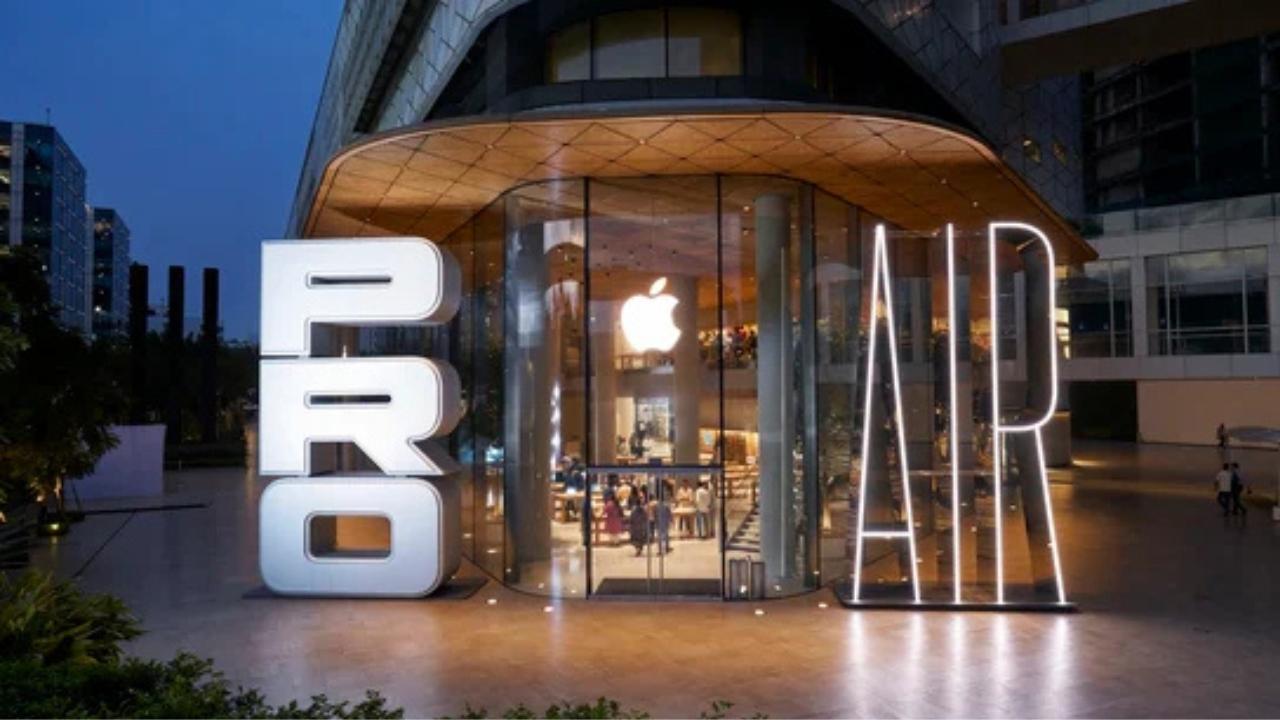
Join 10k+ people to get notified about new posts, news and tips.
Do not worry we don't spam!

Post by : Anis Farhan
Photo: X@TimCook
In recent years, Apple’s presence in India has gone from being limited and aspirational to bold, physical, and costly. The company is no longer just selling via third-party retailers and online channels. It is building flagship stores, leasing premium malls, securing large office spaces, and entering long‐term lease arrangements with significant financial commitments.
For a brand like Apple, real estate is more than just storefronts. It’s about visibility, customer experience, brand prestige, and a concrete signal of commitment to a market. But these ambitions come with serious costs—monthly rents, deposits, revenue sharing, steep escalation clauses, and lock-in periods. For Apple, each store or office is a bet: on consumer demand, on infrastructure, on the continued growth of India’s premium consumer base, and on its ability to sustain margin under high fixed overheads.
Below, we unpack Apple’s major deals, examine what they reveal about its strategy, assess the financial and market implications, and consider what Apple and other brands need to watch out for.
Apple’s recent leases and store opens in India include some of the most expensive retail real estate deals in the country. Here are several high-profile examples:
In Bandra Kurla Complex (BKC) in Mumbai, Apple secured approximately 6,500 square feet in a prime mall location under a five-year lease, paying a high per-square-foot monthly rate, along with a large security deposit and lock-in periods spanning multiple years.
In Borivali, a Mumbai suburb, Apple leased over 12,600 square feet at a suburban premium mall under a lease period of 10 years plus 10 months. Monthly rent for this space is in the tens of lakhs of rupees, with a significant deposit and revenue-sharing component.
In Bengaluru’s Hebbal, Apple leased about 8,000 square feet of retail space for its third Indian store. The deal includes steep annual rent, a security deposit, escalation clauses (rent increase) every few years, and sharing a portion of revenue with the mall owners, subject to caps.
Apple’s store in Delhi (Saket, in a prominent mall) occupies around 8,400 square feet and comes under a long‐term lease. Again, rent escalations are built into the lease, reflecting rising commercial real-estate values in premium locations.
Beyond retail, Apple has also secured large non-retail office leases, like over 2.7 lakh square feet in Bengaluru for its operations, with long lease durations and annual rent hikes. These spaces support Apple’s backend functions: engineering, testing, operations, and administrative work.
These deals share several common features: large invoices, high upfront security deposits, multi-year lock-in clauses, periodic rent escalations, revenue share commitments in some cases, and locations chosen for prestige, footfall, and visibility.
Why is Apple willing to pay so much? What makes these deals worthwhile from its perspective? A few interlocking reasons:
Brand Presence & Flagship Appeal
Apple stores are not just retail points; they're brand statements. Locations in premium malls or luxury shopping districts contribute hugely to brand perception. Customers expect a certain aesthetic — architecture, interiors, service, experience— and premium real estate enables that.
Consumer Demand & Premium Segment Growth
India’s premium smartphone market is expanding, with more consumers able to afford high-end devices and accessories. Apple is targeting not just volume but value. A premium store in a high foot traffic mall can deliver both prestige purchases and accessory sales, service, etc., which often carry high margins.
Direct Control Over Customer Experience
Having its own stores allows Apple to manage the shopper’s entire journey — from first impression, product experience, support services, to after-sales. This is harder when relying only on resellers. It helps Apple maintain a consistent global standard, boosting loyalty, prestige, and possibly even pricing power.
Long-Term Commitment to the Market
Large leases, deposit commitments, multiyear lease periods, office expansions—all signal that Apple sees India as a growing core part of its global strategy. These are not short experiments but long-term bets. Infrastructure, staff training, local supply chains, manufacturing ties are also part of this big picture.
Economies of Scale & Spread of Overheads
Though initial cost is high, fixed costs such as security deposit, fit-outs, utilities, staff training can be spread over many years of operation and large volumes. The deals often include clauses to increase rent gradually, allowing Apple to adjust for inflation or market rentals without surprising rent shocks.
Breaking down what Apple pays helps appreciate the financial load. The cost structure typically includes:
Base Monthly/Annual Rent: The core cost for occupying the space. Rents in premium malls and in prime locations are steep. Multi-floor showrooms cost more. Suburban malls cost somewhat less, though rates are still premium due to Apple’s brand leverage.
Security Deposit: Large upfront sums are common. Apple pays large deposits to secure favorable lease terms, and the deposit amount typically scales with rent or duration of lease.
Escalation Clauses: Many leases include periodic rent hikes every few years—commonly about 15% every three years. This protects landlords from inflation and market shifts, but means Apple’s fixed costs rise over time.
Revenue-Sharing or Percentage Rents: Some agreements require Apple to share a portion of store revenue (often a small percentage) with the mall owner/lessor, particularly when revenues exceed certain thresholds. There is usually a cap so that the share doesn’t exceed some fixed multiple of minimum guaranteed rent.
Common Area Maintenance (CAM) & Mall Charges: Beyond rent, Apple also pays for shared maintenance of the mall, utilities, parking, and other shared facilities. These charges are additional and can sum up to significantly increase monthly costs.
Lock-in Periods: Leases often contain lock-in periods where Apple cannot exit, change location, or renegotiate terms. This ensures the landlord has guaranteed income for certain initial years.
Fit-out, Interior, Store-Specific Costs: Designing stores in Apple’s style (premium materials, lighting, experience zones, etc.) adds heavy one-time costs. These are sunk costs that Apple expects to amortize over many years.
These costs are huge. Apple is spending crores of rupees every month just in rent for several locations. In addition, large deposits often cost a similar magnitude. The investment in infrastructure (store interiors, staff training, renewable energy features, climate control, design) further adds to capital expenditure.
However, the return expectations are correspondingly high. The stores are expected to:
Generate strong product sales (iPhones, Macs, iPads, accessories) especially during launches.
Contribute service revenue (repairs, technical support, accessories).
Drive brand prestige, which helps Apple maintain higher margins and pricing.
Act as customer experience hubs. The physical presence helps retention, trust, and upselling.
Support localized growth in premium segments. As cities get richer, more consumers move into the category Apple targets.
In fact, the first flagship stores in Mumbai and Delhi have reportedly registered substantial revenues, running into hundreds of crores annually. Their monthly averages are consistent and strong. These stores have become among Apple’s best globally in terms of revenue per store.
The geographical spread and locations Apple is choosing are strategic:
Major metros first: Mumbai and Delhi are natural choices because they house the highest concentrations of premium consumers and are trendsetters.
Expanding into suburbs of major cities: Borivali in Mumbai is an example. While suburbs have lower status than central business districts, they offer access to growing affluent populations, lower land cost relative to the very center, and large new malls. Apple is striking balance: premium exposure + wider reach.
Selecting large, high-traffic shopping malls that are landmark destinations. Mall developers love Apple as a tenant because it draws foot traffic, prestige, and often helps anchor other luxury brands.
Cities where Apple also invests in offices and manufacturing are preferred because they create synergy: supply chain, staffing, R&D, operations benefit from being near retail points.
Apple’s strategy does not come without risk. Some of the potential downsides are:
High Fixed Costs
Even during low demand seasons, Apple must pay rent, maintenance, employee salaries, utilities etc. If sales decline or footfall drops (due to economic slowdown, competition, or macro events), profitability can suffer.
Real-Estate Market Volatility
Commercial real estate rents may rise faster than projections. Escalation clauses help with that, but sometimes mall occupancy, footfall, or infrastructure issues can lag investment. If infrastructure around store (parking, roads, access) is poor, customer experience suffers.
Competition & Substitutes
Competing brands and other luxury or premium product makers may raise their own retail ambitions. Moreover, online retail remains a strong competitor especially if consumers find cheaper deals or promotions online.
Regulatory / Policy Uncertainty
Lease laws, real-estate regulations, taxes, GST, import duties for electronics and accessories—any change can affect costs. For example, obtaining permissions for large retail banners, signage, local compliance, etc., can impose delays or costs.
Consumer Behavior Changes
If interest and foot traffic drop because of changing shopping habits (more online, less in-mall time, cost sensitivity), high overhead flagship stores may become less profitable.
Maintaining Standard & Experience
Apple’s store design expectations (materials, interiors, renewable power, skilled staff) set very high standards. Ensuring consistent quality across multiple stores, particularly in less mature retail markets or suburban malls, adds complexity and cost.
Apple’s moves are not just about Apple—they shift norms in real estate, retail leasing, mall management, and consumer expectations.
Rental benchmarks: Apple’s high rents set new high-water marks for commercial real estate in premium malls. Other luxury or global brands will now benchmark themselves against what Apple pays. This pushes up costs for other tenants.
Mall developers & landlords: Having Apple as a tenant improves prestige, footfall, indirectly lifts rents or occupancy for nearby stores. Mall developers will aggressively pursue such flagship tenants.
Retail mix and mall development: Mixed-use malls, shopping centers with premium branding, good infrastructure, parking, access will gain favor. Developers may invest more in amenities, façade design, interiors, experience zones, and ensure tenants like Apple find them attractive.
Employment & supply chain: These stores need staff, technical support, training, security, logistics. Local vendors, contractors, fabricators, interior designers will benefit. Also, Apple’s office leases suggest investments in engineering, operations, which may support jobs in tech/services downstream.
Consumer behavior: As more flagship Apple stores open, more people may prefer to experience products in person. That may affect how consumers buy accessories, how they judge devices, how much premium they are willing to spend. Physical retail still matters.
To ensure its real estate investments deliver returns and to minimize risk, Apple should (and appears to be) focus on:
Disciplined site selection: Prioritizing locations with strong projected footfall, infrastructure, convenience, brand synergy, customer access. Premium malls, accessible via public transport, located in affluent neighborhoods.
Cost control while maintaining experience: Ensuring high-quality store interiors and branding without overpaying. Negotiating tenant improvements, revenue share caps, and favorable lease clauses.
Flexible lease terms: Being able to adapt to changing retail trends is important. It helps if leases allow adjustments, give options for expansion or modifications, ease renewals, lock-ins that aren’t too restrictive.
Omni-channel integration: Many customers may discover products online and then visit stores, or buy in store and seek online support. Physical stores must support this hybrid behavior: order pick-ups, showcases, service, workshops, etc. Stores that only serve as showrooms may be less profitable than those that also provide service and brand experience.
Focus on sustainability and local relevance: Renewable power, local materials, culturally resonant design may help reduce operational costs and improve brand image. Also staff trained to local preferences. Localization in product offerings and accessories helps.
Monitor metrics closely: Footfall, conversion rate, revenue per square foot, cost per square foot, maintenance costs. If a store underperforms, consider whether space reduction, relocation, or redesign is needed.
For ordinary consumers, Apple’s real-estate investments bring both benefits and trade-offs.
Pros:
More premium Apple store locations means more people can physically experience devices, accessories, technical support, service features. That adds value particularly for expensive devices.
Flagship stores often carry the latest models, full accessory lines, workshops, and better displays, giving customers the full Apple experience.
Local presence often means better support service, easier repairs or returns, better guarantees of authenticity and warranty.
Cons / What to Watch Out For:
Prices in flagship stores tend to reflect the premium: overheads, rental costs, import duties etc. may be passed to consumers. Some items may cost more than online or smaller reseller outlets.
If Apple picks locations far from your area (premium malls in central districts), access costs (travel, parking, time) go up.
Promotional discounts may be rarer in flagship stores; loyalty or graduation discounts may exist but flagship positioning often comes with less discounting.
Given Apple’s current trajectory and what is publicly known, future trends are likely to include:
More stores beyond the metros, especially in large Tier-2 cities where premium demand is growing and retail mall infrastructure is coming up.
Further expansion in suburbs and satellite towns of metro cities as the affluent population spreads out.
Greater integration between Apple’s offices, supply chain, and manufacturing in India. More office leases in tech districts, more hiring locally, perhaps more product assembly or R&D in country.
Possibly more revenue share models in leases, especially for new stores where landlord wants to reduce risk, and Apple is willing to bet on sales.
More creativity in store experience: workshops, immersive displays, support centers, innovation labs, etc.
Increased competition among brands for premium retail real estate, which may push up rents, but also push up service levels and customer expectations.
Apple is making big bets with its real-estate strategy in India. Flagship stores, prime locations, high monthly rents, large office leases—all point to a company that is serious about being a long-term player, not just selling phones but building brand, experience, and operations.
The costs are massive. The risks real. But so are the potential rewards: market leadership, customer loyalty, sales margins, brand prestige. If Apple’s stores continue to perform well, the heavy fixed costs will look justified. For consumers, this expansion increases access and experience; for realtors and mall owners, it sets new benchmarks and raises the bar.
In sum, Apple’s retail real estate in India is one of the clearest signals yet that global premium brands believe in a premium future for this market—and are willing to pay for it.
This article is based on verified reports and public lease documents as of September 2025. Rental terms, store sizes, or financial obligations may change as new leases are signed or renewals occur.










Suranika Roshan Celebrates Bakery Launch with Saba Azad's Support
Suranika Roshan opens her bakery, The Moon Beam Bakery, as Saba Azad shares an encouraging message o

Jets Make History with Unprecedented Special Teams Touchdowns
In a landmark game, the Jets scored two touchdowns on special teams, making franchise history with a

Chargers Secure 25-10 Win Over Steelers with Strong Defense and Herbert's Leadership
Los Angeles Chargers triumphed over the Pittsburgh Steelers 25-10, showcasing a formidable defense a

Rams Triumph Over 49ers; Adams Left with Minor Oblique Injury
The Rams secured a 42-26 win against the 49ers, but Davante Adams left the game in the fourth quarte

Jurel's Stellar Performance Raises Selection Dilemmas for India
Ahead of the South Africa Tests, Dhruv Jurel's impressive form complicates team selection as Rishabh

Ryan Williams Embraces Indian Identity, Joins Football Camp
Ryan Williams has transitioned from Australia to India, joining the national football camp in Bengal